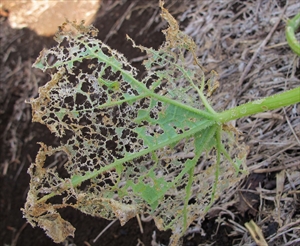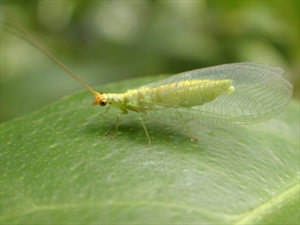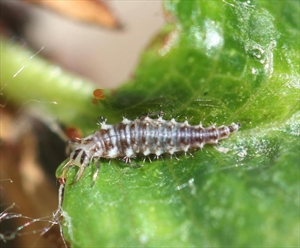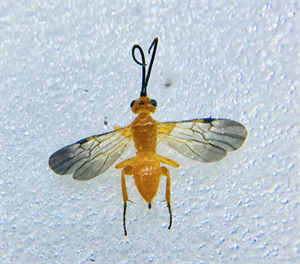Cucumber moth. Other common names are, melon moth, pumpkin caterpillar, cucurbit caterpillar, watermelon worm. In Southeast Asia, it is known as the white cucumber moth, with WCM as the acronym.
Pacific Pests, Pathogens and Weeds - Online edition
Pacific Pests, Pathogens & Weeds
Cucumber moth (033)
Diaphania indica. A moth of the Crambidae.
Asia, Africa, North (Florida) and South America, the Caribbean, Europe, Oceania. It is recorded from Australia, American Samoa, Federated States of Micronesia, Fiji, French Polynesia, Guam, Kiribati, Marshall Islands, Northern Mariana Islands, Palau, Papua New Guinea, Solomon Islands, Tonga, and Vanuatu.
Cucurbits; common cucurbits are watermelon, cucumber, melon, pumpkin, snake gourd, and bitter gourd.
The caterpillars do the damage. The small caterpillars (larvae) are often found in the expanding leaves of the new growth, and with those of medium size, feeding on the leaves between the veins (Photo 1). At a later stage, the larvae roll the leaves and feed from inside, and also pupate in the leaf rolls (Photo 2).
The eggs are oval, about 0.7 mm long and 0.4 mm wide, thin walled and whitish. They are laid in small groups on the growing parts of the shoot, usually on the underside of the leaves or on buds and flowers.
The eggs hatch and the caterpillars emerge. They are almost clear, but soon become green. Large caterpillars have two white lines along the back (Photo 3). When fully grown, they are about 20 mm long:
After a while, the caterpillars turn into pupae, green at first then brown (Photo 4). The pupae are in folds of the leaves. They are about 12 mm long and 3 mm wide. The adults hatch from the pupae after about 8-12 days.
The adult is very obvious (Photo 5). The wings are white with a wide brown border. When the wings are spread, they are about 25 mm wide. At the end of the body is a group of hairs, rather like a brush. The females wiggle this brush, possibly to send out a chemical to attract the males. The life cycle from egg to adult is about 25 days.
A serious pest. In Asian countries, it is particularly important on bitter guord, with the larger caterpillars eating the soft-skinned fruit. Apart from attacking the leaves, the caterpillars attack the flowers and reduce the number of fruits set. Young fruits are also attacked: the caterpillars damage the skin and cause the fruits to rot. Late stage caterpillars cause serious damage to bitter gourd by eating the soft-skinned fruit.
Look for small and medium sized caterpillars on the growing tips, new leaves and the underside of larger leaves. Look for fresh leaf chewing and fresh frass (droppings). Note, it is difficult to see the small caterpillars because they are the same colour as the leaves.
NATURAL ENEMIES
All the common foliage dwelling predators will feed on the exposed caterpillars, for instance, lacewings, ladybird beetle adults and their larvae, and hoverfly larva (Photos 6-9). Different species of small parasitic wasps attack the eggs, caterpillars and pupae (Photo 10).
It is important to think about these natural enemies when considering how to control Diaphania. If chemicals are used, it is best to choose those that do not kill natural enemies. Preferably, use chemicals that are allowed under organic vegetable production.
CULTURAL CONTROL
Before planting:
- Avoid overlapping crops cucurbits (cucumber and watermelons, especially).
- Avoid planting new crops next to old where the larvae are present.
- If growing plants in a nursery before field planting, check each for signs of larvae before taking them to the field.
During growth:
- It is important that growers visit the crop frequently and regularly: twice a week is recommended, to check if there are caterpillars rolling the leaves. If found, do the following:
- Check the young leaves, looking for those that are stuck together and those where only the veins are left. Look for faeces on the leaves. They are the signs that caterpillars are present.
- Look for rolled leaves: remove them, or squeeze the leaves to kill the caterpillars inside. Check the flowers and the fruits for damage. If it is severe, consider using an insecticide. But consider carefully which ones to use.
After harvest:
- Collect and burn or bury as much of the crop as possible.
- Leave at least 3 month between crops.
CHEMICAL CONTROL
Acephate (Orthene) is being used by many farmers for the control of this caterpillar in some Pacific island countries, but it is not the best choice. Acephate will kill all insects, whether they are pests or beneficial.
The following pesticides are recommended:
- Use plant-derived products, such as neem, derris, pyrethrum and chilli (with the addition of soap), or commercial products manufactured from disease-causing organisms, such as spinosad (Success) and Bt - Bacillus thuringiensis subspecies kurstaki. Note, in many countries spinosad is being replaced by a related insecticide, spinetoram. Note, too Bt is best applied to young caterpillars.
- Note, a variety of Derris, brought many years ago to Solomon Islands from Papua New Guinea, is effective as a spray. It contains rotenone, an insecticide, so it should be used with caution. There may be varieties of Derris (fish poisons) in your country that can be tried (see Fact Sheet no. 56).
- Synthetic pyrethroids are likely to be effective too, but, as with acephate, they are broad-spectrum insecticides and will also kill natural enemies. They are not recommended.
____________________
When using a pesticide, always wear protective clothing and follow the instructions on the product label, such as dosage, timing of application, and pre-harvest interval. Recommendations will vary with the crop and system of cultivation. Expert advice on the most appropriate pesticides to use should always be sought from local agricultural authorities.
AUTHORS Grahame Jackson, Mani Mua & Helen Tsatsia
Information from Everatt et al. (2015) Cucurbit moths Diaphania species. Plant Pest Fact Sheet. Department of Environment, Food and Rural Affairs. (https://planthealthportal.defra.gov.uk/assets/factsheets/diaphania-indica-nitidalis-hyalinata.pdf); and CABI (2020) Diaphania indica (cucumber moth). Crop Protection Compendium. (https://www.cabi.org/cpc/datasheet/19657); and from Walker K (2007) Cucumber moth (Diaphania indica): PaDIL - http://www.padil.gov.au; Diaphania indica (2020) Wikipedia. (https://en.wikipedia.org/wiki/Diaphania_indica). Photo 3 Wilco Liebregts, Ecoconsult, Fiji. Photos 4&5 Gerald McCormack, Cook Islands Biodiversity & Natural Heritage: (http://cookislands.bishopmuseum.org/). Photo 7 Whitney Cranshaw, Bugwood.org. Photo 8 Suzanne Neave, CABI, UK.
Produced with support from the Australian Centre for International Agricultural Research under project PC/2010/090: Strengthening integrated crop management research in the Pacific Islands in support of sustainable intensification of high-value crop production, implemented by the University of Queensland and the Secretariat of the Pacific Community.













